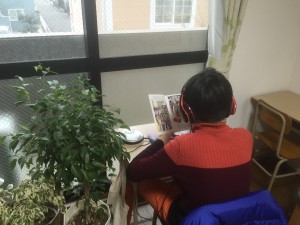A Smorgasbord of Updates
Life has been very busy in the almost two months since the last post. Here are a number of small news items.
1. Extensive Reading Outreach
I am working with another high school in Sendai, mainly providing advice on which books to buy and how to encourage students to read. The teachers and librarian there are really enthusiastic and open to suggestions, so it’s been a lot of fun so far. Hoping to see their reading program develop.
2. University Classes
Continued to develop classes here at Tohoku University, particularly the new ‘high level’ ones.
3. PELLT Expansion
We’ve made some new pages on PELLT, with more to come soon.
4. Cambridge Academy Development
Some progress, including training part-timers to take the ER classes, getting more books, and working on the fluency program in the output classes.
5. RetireJapan
Lots of new content on the RetireJapan site, and featured speaker at JALT national.
Hope to have some more posts for you soon 🙂
Cambridge Discovery Interactive Readers
Great news
Last year I took another look at the excellent Cambridge Discovery Interactive Readers (full review coming soon) and was disappointed to see that a lot of the content was set up to be accessible to a single user for a limited time. It seems the publisher assumes they will be bought by individuals and used as a kind of textbook.
Of course, this is very different to how ER program administrators look at books.
For me, I am not interested in the interactive questions or even videos (although it would be nice if they were on a public site accessible by anyone), but I am very interested in having the audio files available so I can make CDs for our students.
I reached out to our local Cambridge University Press rep, who is a very thorough and approachable guy, and told him I was very interested in having access to the audio files. He asked some questions about my teaching situation, I answered them, and he said he’d talk to the main office.
I assumed that would be the end of it. Few publishers understand ER as practiced in Japan (particularly with regards to the importance of word counts, etc.) and I wasn’t expecting much more than ‘sorry, we can’t do anything at this time’.
This morning I was proved completely wrong. I received an email telling me that the audio files for the first couple of levels are online and can be freely used by teachers and students. Apparently the rest of them will be going up soon.
This is great. I’m really happy to see a big publisher listen to local teachers and help them with their teaching situation. Big kudos to Cambridge for making this change -I hope you’ll check out the series and download the audio. Positive reinforcement works wonders!
Extensive Reading Foundation 2016 Language Learner Literature Awards
It’s the Oscars of the ER world
I’m really happy to post finalists of the ER Foundation LLL Awards for this year. Lots of interesting looking books. I already wrote about Vera the Alien Hunter, and I’m looking forward to checking out the Malala biography very much.
I am slightly disappointed by the large number of rewrites of classic books. I don’t understand why publishers churn out version after version of Tom Sawyer, the Happy Prince, etc. I guess it’s cheaper than writing new content, but two-thirds of the finalists in the higher categories are rewrites this year. I will be voting for original stories over rewrites, and also take this into account when buying books.
Extensive Reading Foundation Language Learner Literature Awards 2016 Finalists
Online comments April 1 – June 30, 2015 at www.erfoundation.org
Winners to be announced at the following vocabulary conferences:
Sept. 12-14: . Winners announced online and at the Vocab@Tokyo Conference, 12-14 September, Meiji Gakuin University, Tokyo. Info: https://sites.google.com/site/vocabattokyo/
You can see all the finalists on this PDF flyer: ERF_2016_Flyer_Final, and the judges comments are here: finalists 2016 with comments.
See anything you like the look of?
e-future Graded Comic Readers extensive reading materials reviews
by sendaiben
11 comments
PREVIEW: Vera the Alien Hunter (Graded Comic Readers)
My students are going to love this
By the same people that brought us Magic Adventures and School Adventures (waiting for the final installment in May before I write a review), this new graded comic book series arrived yesterday. Vera the Alien Hunter is a girl with a vivid imagination. At one point she starts to meet aliens, although it is not clear if this is real or just her imagination. I have the first three volumes of the series (three stories in each): it seems there will be another three volumes, for a total of six volumes and eighteen stories.
The YL and word counts for each level are similar to the Magic Adventures comics: YL 0.5-0.9, and 300-500 words or so per story.
The Good
- Really attractive artwork and fun stories.
- The audio is very high quality
- Word counts on all the books! Well done e-future.
The Bad
- The CD is an MP3 CD, which means it doesn’t work with most of our CD players or the students’ ones at home. Pretty disappointed about this, especially as the previous comics had real CDs. Note for publishers: please use normal CDs if at all possible.
- The books have three stories in each rather than being separate books. This could be a drawback in terms of flexibility (ie more students could use them if they were one book per story).
Overall
This is a great addition to the e-future comics collection. I’m looking forward to the last three volumes and can’t wait to share them with our students (once we re-record the CDs from MP3 to audio).
curriculum extensive listening extensive reading Language learning speaking
by sendaiben
12 comments
Shadoku Explained
Adding shadowing to beginner extensive reading has immense potential
I’ve been meaning to write this post for a while. I’d like to thank Yuko Suzuki, who first told me about the huge potential of incorporating shadowing practice into extensive reading classes for beginners/lower-level students. If you have a chance to see one of her presentations I recommend you take it -she’s a very effective teacher and presenter.
So what is shadoku? Well, it is a term coined by me as a gag over lunch at a seminar in Fukuoka. I’m kind of chuffed that it has been adopted somewhat by the community 😉
Shadoku is shadowing and tadoku (extensive reading).
Shadowing is a type of speaking fluency practice that involves attempting to speak along with another person or an audio source. It is different from repeating. When doing read and repeat, for example, the source would speak first, then the learner would repeat. In shadowing, the source would speak, then the learner would attempt to say the same thing at the same time with the smallest lag possible. One feature of shadowing is that learners are encouraged to imitate the speaker’s tone, intonation, emotion, and pronunciation.
This video gives a brief explanation of shadowing.
So how does this work with tadoku (extensive reading)?
Well, I have only been experimenting with this for a few months, and we rolled it out to all the beginner students in the Cambridge Academy last week.
I have adapted (messed up?) Yuko’s technique slightly, so I will introduce my version of shadoku below.
For beginners (mainly junior high school first years and elementary students) I am planning to do shadoku as described below until they reach YL 0.4, at which point I may allow them to read and listen instead, or we may continue with shadoku if that seems appropriate at the time. Basically this year is another learning experience for me.
How to do shadoku
There are four steps in my version of shadoku, so a student will read each book four times.
Step one: look at the pictures, think about the content. At YL0.1-0.3 there are plenty of pictures in the books and students can guess a lot of the content just from that. This step takes a minute or two, and we encourage students to look closely at details in the pictures.
Step two: listen to the audio and read along silently. This step allows students to focus on how to pronounce words and how the English sounds when spoken.
Step three: listen to the audio, read along, and shadow out loud. This step allows students to shadow assisted by the text.
Step four: listen to the audio and shadow out loud. Do not open the book. This step allows students to use their listening skills and short-term memory to shadow successfully. I also encourage students to think about the meaning of what they are saying during this step.
Introducing shadoku
For the first three or four classes I have students do shadoku as a group, with me leading them. I introduce each step (I have a notebook with the four steps that I show to remind students), play the CD when necessary, and give students feedback and advice. Students shadow together as a group, which makes them feel less self-conscious and allows more confident/keener students to set a good example.

I use these diagrams to explain shadoku
After a few classes and once students are more confident, we do group shadoku at the beginning of class and then students work individually with headphones and personal CD players in the latter half. They are also expected to continue practicing in the same way at home.
The benefits of shadoku
I haven’t been using shadoku with my students for long, but already I am really happy with how things are going. I’ve been asking all our new students (starting at YL 0.1) to do shadoku, and am currently planning to have them continue until they reach YL 0.4 or so.
The main benefit is that students are much more involved in the task.
Previously when we did reading while listening some students were clearly zoning out. I had a couple who appeared not to have made any progress mid-year so I had to have them go back to the beginning and do intensive work reading to me, etc.
I can’t see that happening this year, as I can hear the students practicing and can monitor if they are getting the right pronunciation, intonation, etc.
The students also seem happier and the atmosphere in class is much better than last year.
Conclusion
This is still a work in progress. So far so good, but we’ll see if students get bored or some unexpected problem pops up. We’ll also have to see where it would be appropriate to stop doing shadoku in class and transition to reading and listening. I suspect it’s going to be when students move from YL 0.3 to 04, but I’m not sure and look forward to trying it out in a couple of months’ time.
Anyone else using shadoku? Anything to add?




